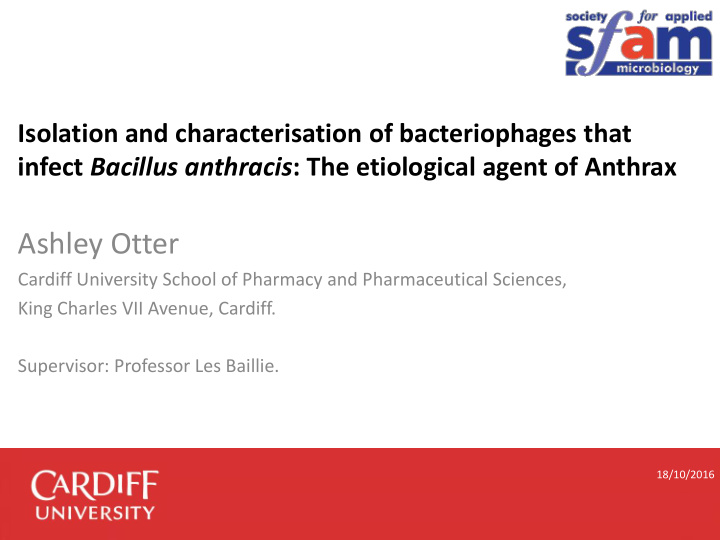



Isolation and characterisation of bacteriophages that infect Bacillus anthracis : The etiological agent of Anthrax Ashley Otter Cardiff University School of Pharmacy and Pharmaceutical Sciences, King Charles VII Avenue, Cardiff. Supervisor: Professor Les Baillie. 18/10/2016
Introduction • Phages are the most abundant entity – 10 31 . • Phages exist as lytic and lysogenic. • B. anthracis is cause of zoonotic disease Anthrax. • 3 types of disease: – Cutaneous, Inhalational and Gastrointestinal (+ injection). • Produces three toxins: – Protective antigen, Lethal Factor and Edema Factor. • Considered bioterrorism threat: – Biowarfare agent – Category 3/A organism. – Considerable research after 2001 ‘Amerithrax’ attacks. • Clinically detected using diagnostic phage ( γ phage) as well as other methods. • Most recent UK case – March 2013 – Fatal infection in injecting heroin user 18/10/2016
Aims and Objectives 1) To isolate bacteriophages from surrounding areas of Cardiff and parts of Wales. 2) Characterise the bacteriophages. 3) Determine the host range of newly isolated bacteriophages. 4) Analyse the genomes of each bacteriophage using RFLP procedures and compare with other known bacteriophages. 5) Analyse proteins of each isolated bacteriophage via SDS- PAGE and compare with known bacteriophages. 6) Sequence the genomes of our newly isolated bacteriophages. 7) To study horizontal gene transmission. 18/10/2016
Bacteriophage isolation from soil 37°C Bacteria and phage + 25 ml TSB Phage solution 18 – 24 hours separated + 10 ml B. anthracis 20 mins. 5,000 x g 25g soil Centrifuge Vortex Filter Soil from sample site 18/10/2016
Bacteriophage isolation from soil 37°C + 25 ml TSB 18 – 24 hours + 10 ml B. anthracis 20 mins. 5,000 x g Centrifuge Vortex 18/10/2016
Bacteriophage isolation from soil 37°C Bacteria and phage + 25 ml TSB Phage solution 18 – 24 hours separated + 10 ml B. anthracis 20 mins. 5,000 x g 25g soil Centrifuge Vortex Filter Soil from sample site 18/10/2016
Bacteriophage isolation from soil 37°C + 25 ml TSB 18 – 24 hours + 10 ml B. anthracis 20 mins. 5,000 x g Centrifuge Vortex 18/10/2016
Isolated bacteriophages • Isolated on B. anthracis Sterne 34F2: RW, AB1, LC1H911, GLJ5A2, GLJ7A2 and NMAB11. • Isolated on B. cereus ATCC 4342: BP8, BP10, TW511A, TW8, LH1 and LH3. 18/10/2016
Results 18/10/2016
Results PlcR – Sastalla et al. (2010) 18/10/2016
Results I II III IV
Conclusions • Specificity Species phage is capable of infecting Phage Number of Bacillus Number of ( Bacillus …) isolates phage can different Bacillus infect species phage can • LH1 and LH3 – Same? infect anthracis, cereus, mycoides & RW 7 4 thuringiensis. • LC1H911 – Host range anthracis, cereus, subtilis, megaterium, AB1 9 6 pseudomycoides & thuringiensis. anthracis, cereus & thuringiensis. BP8 10 3 BP10 anthracis, cereus, mycoides, • pX01 – Abshire et al. (2005) 33 6 pseudomycoides, weihenstephanensis and thuringiensis. anthracis, cereus, mycoides, LH1 40 6 pseudomycoides, weihenstephanensis & thuringiensis. LH3 anthracis, cereus, mycoides, 40 6 pseudomycoides, weihenstephanensis & thuringiensis. anthracis, cereus, mycoides & TW511A 6 4 thuringiensis. anthracis, mycoides & thuringiensis. TW8 4 3 anthracis & mycoides. LC1H911 5 2 anthracis, cereus, subtilis, licheniformis, 3B6 50 8 megaterium, mycoides, weihenstephanensis & thuringiensis. Gamma anthracis, cereus, mycoides & 12 4 thuringiensis. 18/10/2016
Conclusions • Specificity • LH1 and LH3 – Same? • LC1H911 – Host range • PlcR • pX01 – Abshire et al. (2005) Species Isolate AB1 RW LC1H911 Gamma BP8 BP10 LH1 LH3 TW511A TW8 + + + + - - - - - - B. anthracis 34F2 - + + - - - + + + - ΔGerH + + + + - - + + + - SdT + + + + + + + + + + SdT12 18/10/2016
Future work • Testing against virulent B. anthracis • Electron microscopy – October 2014 • RFLP/Sequencing • MOD (DSTL) project: • “ Feasibility study into the use of bacteriophages against B. anthracis s pores” • DSTL contract: DSTLX1000095774 • SfAM 18/10/2016
Acknowledgements I would like thank all members of Lab 1.11 (Dr. Bettina Schelke, Dr. Callum Cooper, Dr. Tina Joshi, Chris Hatton, James Blaxland and Jennifer Hawkins) as well as everyone in Lab 1.49 (Dr. Mark Legget, Harsha Siani, Dr. Maru Saavedra, Dr. Anna Costanlo, Rebecca Wesgate and Leonam Goncalves) for all their help with lab work and helping me have an awesome time. I’d also like to thank my PTY supervisor, Prof. Les Baillie, for all his help and guidance with experiments and data analysis throughout, Dr. Beatrix Fahnert for her pastoral and academic support as my personal tutor as well as the Society for Applied Microbiology for their funding in my project. I also thank Professor Baillie, Dr. Cooper and Professor P. Keim for use of their photos in my presentation. References Abshire, T. G., Brown, J. E. and Ezzell, J. W. (2005). Production and validation of the use of gamma phage for identification of Bacillus anthracis . Journal of clinical microbiology 43: 4780-4788. Sastalla, I., Maltese, L. M., Pomerantseva, O. M., Pomerantsev, A. P., Keane-Myers, A. and Leppla, S. H. (2010). Activation of the latent PlcR regulon in Bacillus anthracis . Microbiology 156: 2982-2993. 18/10/2016
Recommend
More recommend